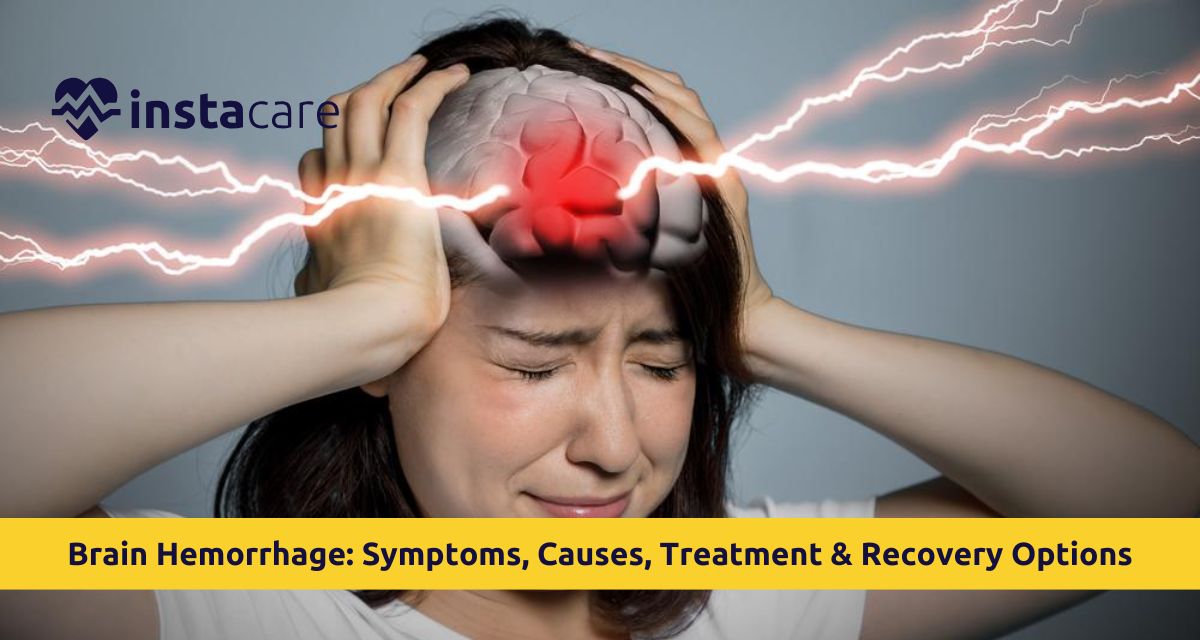Brain hemorrhage is a type of stroke due to bleeding in or around the brain. Brain hemorrhage is when an artery is blocked and bursts and is then supplied with blood in the brain tissue, leading to swelling and rising pressure, and death of brain cells. Brain hemorrhage is an emergency and must be treated immediately before permanent damage or death occurs.
Even less common as a percentage of strokes, a brain hemorrhage will be more likely to kill. Quick action, awareness of symptoms, and early treatment will save lives and improve recovery rates.
What Is a Brain Hemorrhage?
A brain hemorrhage is when a ruptured vessel bleeds into the brain. Depending on where the bleeding is occurring, it can be classified in several categories:
- Intracerebral hemorrhage: bleeding inside brain tissue
- Subarachnoid hemorrhage: bleeding in space and thin covering tissue over the brain
- Subdural or epidural hematomas: bleeding between layers of covering tissue over the brain
They all vary in severity, locations, and treatments but share one thing in common: pressure on the brain. This kind of pressure kills brain tissue or steals blood of essential components of the brain.
Finding the Signs & Symtoms
The symptoms of brain hemorrhage begin immediately and add up very fast. They should be able to feel them to be properly treated.
- Some others experience an awful headache, the worst headache of their lives. Some lose consciousness or become confused. Some have weakness of one side of the body, slurred speech, altered vision, or gait. Seizures also occur, mainly in those with no history of epilepsy.
- In others, the presentation will be virtually indistinguishable from other conditions like migraine or syncope attacks and thus so easily mistaken. With acute presentation and sudden onset of symptoms, emergency medical evaluation is necessary.
Causes of Brain Hemorrhage
There are numerous habits and medical conditions that cause a brain hemorrhage.
- The most notable one is high blood pressure, or hypertension, which slowly wears away the lining of the blood vessels and can cause a vessel to burst.
- Head injury, especially due to car accident or a fall, i.e., an aneurysm, a balloon-shaped swelling of the arteries, that also may rupture and cause bleeding, are another hazard. Bleeding disorders that cause interference in clotting or drug-treated patients on anticoagulants, are also at risk.
- Drug abuse such as amphetamines or cocaine, can result in a sudden increase in blood pressure and bursting of the vessels. Brain tumour, liver disease, or arteriovenous malformations (defective vessels) are also accountable for triggering hemorrhage attacks.
Diagnosing Brain Hemorrhage
This requires early diagnosis so that the outcome is not so horrific. A CT scan is generally employed, which is able to detect bleeding within minutes. An MRI is employed if greater specificity is needed, to scan intensively the condition of the brain.
In other cases, cerebral angiogram is used in the diagnosis of vascular disease like aneurysm or malformation. In other cases where subarachnoid hemorrhage cannot be diagnosed through scans, lumbar puncture (spinal tap) is used to create cerebrospinal fluid with blood.
Early and accurate diagnosis leads to proper selection of treatment protocol without losing valuable time.
Treatment of Brain Hemorrhage
Treatment of a diagnosed brain hemorrhage is to decompress, stop bleeding, and most importantly, not harm. Physicians may prescribe medicine or surgery based on severity.
Alternatives best are:
- Regulation of blood pressure so as not to bleed any more
- Surgical drainage of blood or repair of leaking blood vessels
- Endovascular procedures like coiling to stop aneurysms
- Medications to control swelling, seizures, or disorders of blood clotting
In the most severe cases, craniotomy (skull trephining) may be required to remove ginormous blood clots. In the case of small bleeds, supportive care and intensive care unit observation may be as bad as it gets.
Always the goal is to stabilize the patient, minimize brain damage to the extent possible, and have rehab in progress.
Recovery and Rehabilitation
Recovery from brain hemorrhage varies depending on the size and location of the hemorrhage. Some recover fully, but others will have residual speech, motor, or intellectual deficit.
Rehabilitation improves function and quality of life as well. Physical therapy is started in most patients to improve movement and coordination. Occupational therapy brings the patient's function back to activities of daily living like feeding and dressing. Speech-language therapy is started early in speech impairment.
Psychological counseling should also be mentioned. Patients get depressed, anxious, or experience mood swings after brain injury. Counseling and mental health management are part of long-term rehabilitation.
Rehabilitation goals:
- Physically strengthening and balancing
- Getting independent with activities of daily living
- Enhancing thinking and communication
- Preventing another stroke or complication
- The recovery process takes from a few months to a few years based on the patient and support system condition.
Preventing a Brain Hemorrhage
You are not able to prevent all hemorrhages, but managing the risk factors will cut down your risk. Prevention is optimal with control of blood pressure.
Healthy diets, salt cutting, exercise, and smoking cessation all favor good blood vessels. If you take thinners and/or have an aneurysm family history, follow-up visits to your physician and obedience to medical orders to the extremity are mandatory.
Prevention of head injury is also necessary. Wear seat belts, helmets, and be careful when one is going to engage in risk-taking activities.
Alcohol and drug abuse, especially stimulant abuse, must be avoided not to rupture blood vessels in the brain.
When to Call Your Doctor?
Brain hemorrhage may appear suddenly, so be aware of the time to respond. If anyone develops a sudden crushing
headache, loses consciousness, becomes confused, or develops weakness on one side, do not hesitate. Call emergency straight away.
Other signs and symptoms include slurred speech, blindness, seizure, or unsteady gait. Even if the symptoms are trivial, they could be the precursor to an emergent condition.
Time is of the essence. The patient needs to be hospitalized on time. In this way, their survival and recovery are optimized.
Conclusion
Brain hemorrhage is an emergency condition that must be urgently treated. Recognition of its early signs, immediate intervention, and passage through the rehabilitation process will greatly enhance prognosis. Recovery, however difficult, can be achieved through proper management and care by most. Prevention of complications from conditions of health status such as hypertension and health-threatening conditions includes avoidance of their precipitating factors. Knowledge and awareness can prevent death.
Please book an appointment with the
best Neurosurgeon in Lahore, Karachi, Islamabad, and all major cities of Pakistan through
InstaCare, or call our helpline at 03171777509 to find the verified doctor for your disease.

